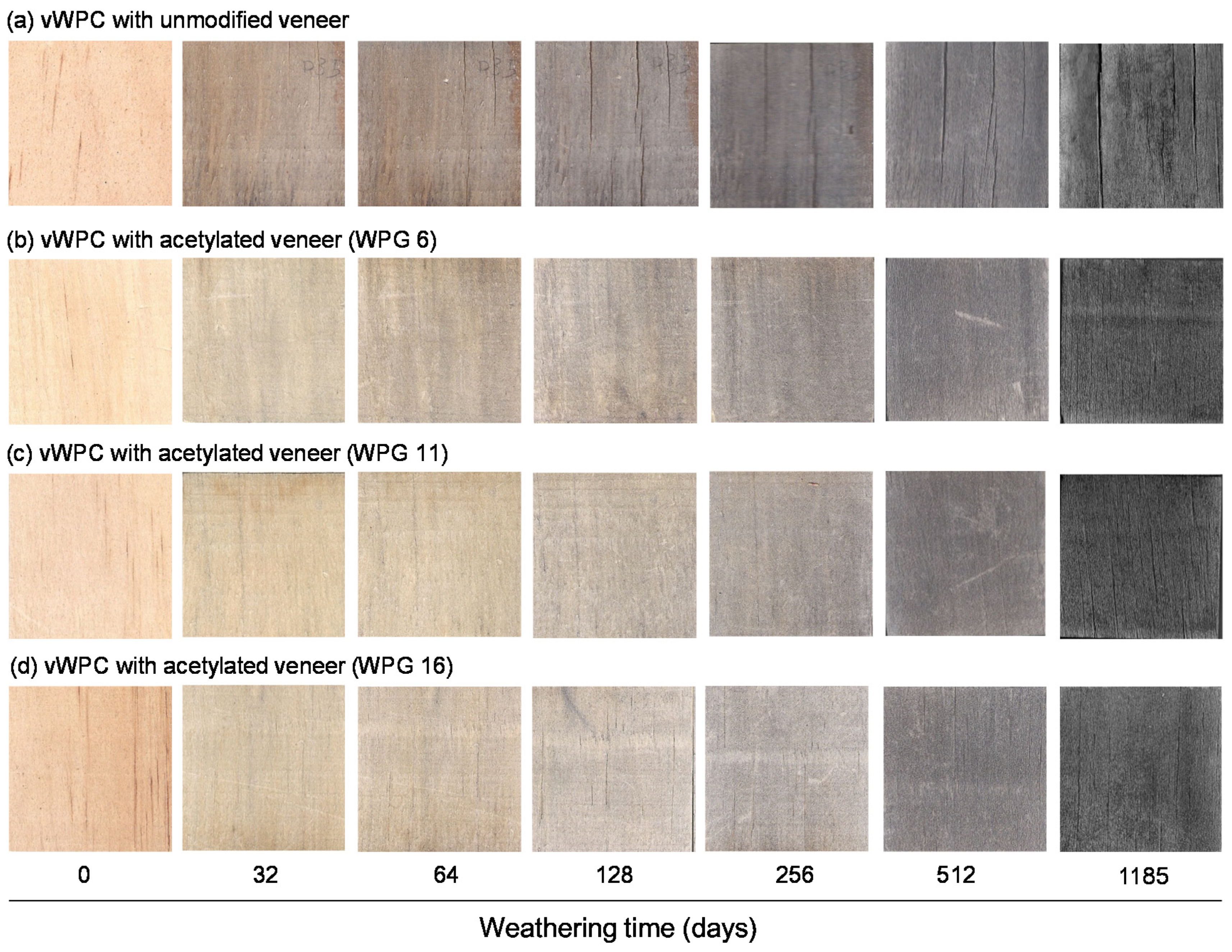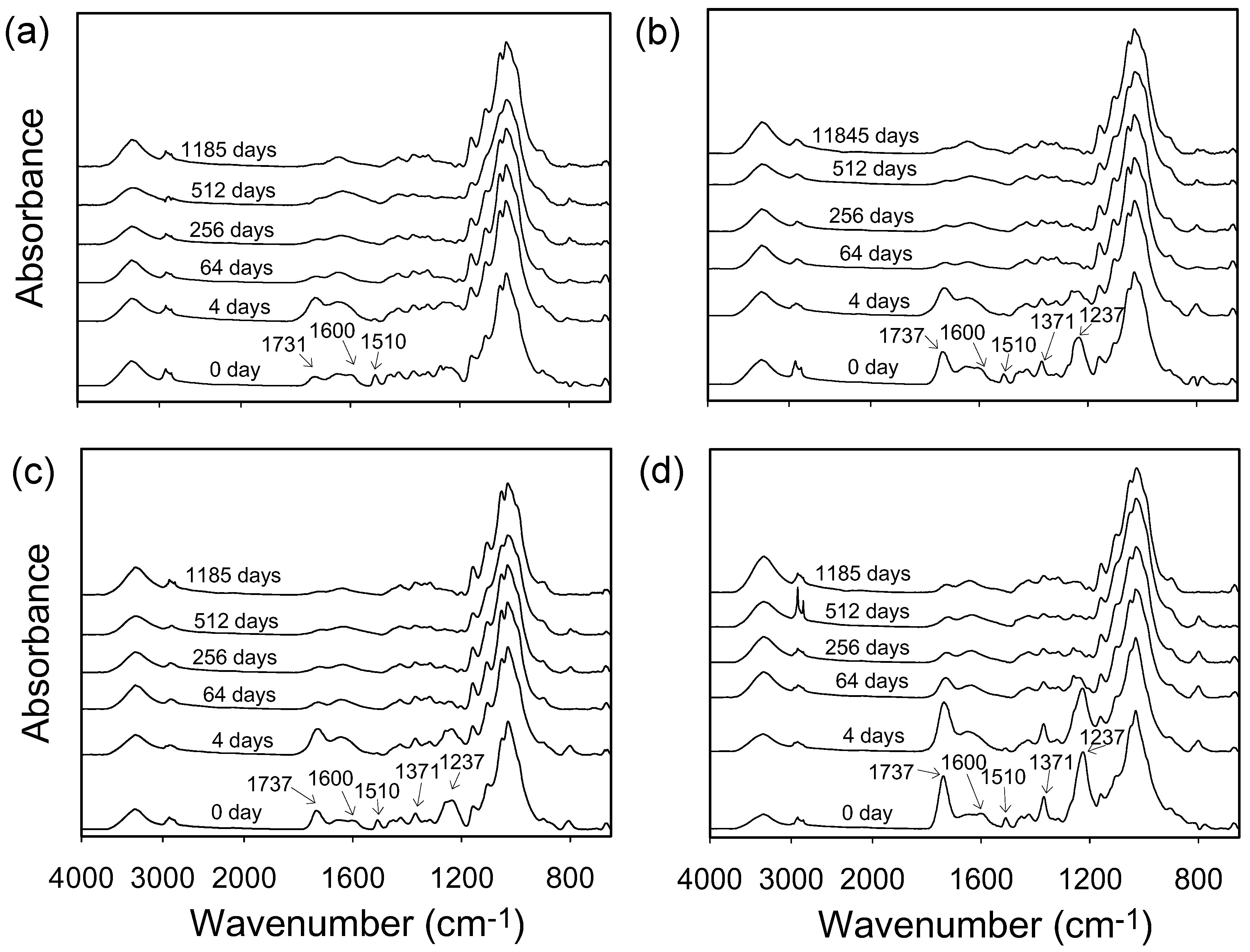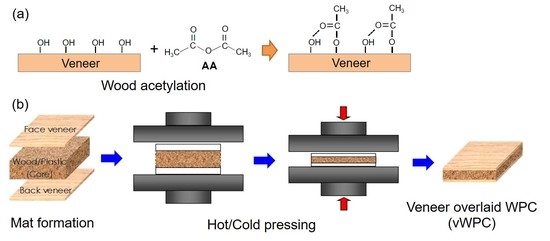Effects of Acetylated Veneer on the Natural Weathering Properties of Adhesive-Free Veneer Overlaid Wood‒Plastic Composites
Abstract
:1. Introduction
2. Materials and Methods
2.1. Materials
2.2. Acetylation Treatments
2.3. Composite Processing
2.4. Natural Weathering Test
2.5. Determination of vWPC Properties
2.6. ATR-FTIR Spectral Measurements
2.7. Measurement of Surface Color
2.8. Analysis of Variance
3. Results and Discussion
3.1. The Physical and Flexural Properties of vWPCs
3.2. Characteristics of the vWPCs During Natural Weathering
3.2.1. Appearance characteristics of the vWPCs during natural weathering
3.2.2. Color Changes of the vWPCs During Natural Weathering
3.2.3. Mechanical Properties of the vWPCs During Natural Weathering
3.2.4. ATR-FTIR Analysis of vWPCs During Natural Weathering
4. Conclusions
Author Contributions
Funding
Conflicts of Interest
References
- Stark, N.M.; Matuana, L.M. Characterization of weathered wood-plastic composite surfaces using FTIR spectroscopy, contact angle, and XPS. Polym. Degrad. Stabil. 2007, 92, 1883–1890. [Google Scholar] [CrossRef]
- Lei, Y.; Wu, Q. Wood plastic composites based on microfibrillar blends of high density polyethylene/poly(ethylene terephthalate). Bioresour. Technol. 2010, 101, 3665–3671. [Google Scholar] [CrossRef]
- Chand, N.; Fahim, M. Tribology of Natural Fiber Polymer Composites; Woodhead Publishing: Cambridge, UK, 2008. [Google Scholar]
- Hsu, C.Y.; Yang, T.C.; Wu, T.L.; Hung, K.C.; Wu, J.H. The influence of bamboo fiber content on the non-isothermal crystallization kinetics of bamboo fiber-reinforced polypropylene composites (BPCs). Holzforschung 2018, 72, 329–336. [Google Scholar] [CrossRef]
- Kiguchi, M.; Kataoka, Y.; Matsunaga, H.; Yamamoto, K.; Evans, P.D. Surface deterioration of wood-flour polypropylene composites by weathering trials. J. Wood Sci. 2007, 53, 234–238. [Google Scholar] [CrossRef]
- Ndiaye, D.; Fanton, E.; Morlat-Therias, S.; Vidal, L.; Tidjani, A.; Gardette, J.-L. Durability of wood polymer composites: Part 1. influence of wood on the photochemical properties. Compos. Sci. Technol. 2008, 68, 2779–2784. [Google Scholar] [CrossRef]
- Stark, N.M. Effect of weathering cycle and manufacturing method on performance of wood flour and high-density polyethylene composites. J. Appl. Polym. Sci. 2006, 100, 3131–3140. [Google Scholar] [CrossRef] [Green Version]
- Dunningham, E.A.; Plackett, D.V.; Singh, A.P. Weathering of chemically modified wood. Natural weathering of acetylated Radiata pine: Preliminary results. Holz. Roh. Werkst. 1992, 50, 429–432. [Google Scholar] [CrossRef]
- Evans, P.D.; Wallis, A.F.A.; Owen, N.L. Weathering of chemically modified wood surface. Natural weathering of Scots pine acetylated to different weight gains. Wood Sci. Technol. 2000, 34, 151–165. [Google Scholar] [CrossRef]
- Feist, W.C.; Rowell, R.M.; Ellis, W.D. Moisture sorption and accelerated weathering of acetylated and methacrylated aspen. Wood Fiber Sci. 1991, 23, 128–136. [Google Scholar]
- Altenbach, H. Theories for laminated and sandwich plates. Mech. Compos. Mater. 1998, 34, 243–252. [Google Scholar] [CrossRef]
- Najafi, S.K.; Tajvidi, M.; Hamidina, E. Effect of temperature, plastic type and virginity on the water uptake of sawdust/plastic composites. Holz. Roh. Werkst. 2007, 65, 377–382. [Google Scholar] [CrossRef]
- Adhikary, K.B.; Pang, S.; Staiger, M.P. Dimensional stability and mechanical behaviour of wood-plastic composites based on recycled and virgin high-density polyethylene (HDPE). Compos. Part B-Eng. 2008, 39, 807–815. [Google Scholar] [CrossRef]
- Yang, C.N.; Hung, K.C.; Wu, T.L.; Yang, T.C.; Chen, Y.L.; Wu, J.H. Comparisons and characteristics of slicewood acetylation with acetic anhydride by liquid phase, microwave, and vapor phase reactions. Bioresources 2014, 9, 6463–6475. [Google Scholar] [CrossRef] [Green Version]
- Lee, C.H.; Wu, T.L.; Chen, Y.L.; Wu, J.H. Characteristics and discrimination of five types of wood-plastic composites by FTIR spectroscopy combined with principal component analysis. Holzforschung 2010, 64, 699–704. [Google Scholar] [CrossRef]
- Lee, C.H.; Hung, K.C.; Chen, Y.L.; Wu, T.L.; Chien, Y.C.; Wu, J.H. Effects of polymeric matrix on accelerated UV weathering properties of wood-plastic composites. Holzforschung 2012, 66, 981–987. [Google Scholar] [CrossRef]
- Iwamoto, Y.; Itoh, T. Vapor phase reaction of wood with maleic anhydride (I): Dimensional stability and durability of treated wood. J. Wood Sci. 2005, 51, 595–600. [Google Scholar] [CrossRef]
- Dominkovics, Z.; Dányádi, L.; Pukánszky, B. Surface modification of wood flour and its effect on the properties of PP/wood composites. Compos. Part A-Appl. S. 2007, 38, 1893–1901. [Google Scholar] [CrossRef]
- Ohamae, K.; Minato, K.; Norimoto, M. The analysis of dimensional changes due to chemical treatments and water soaking for hinoki (Chamaecyparis obtusa) wood. Holzforschung 2002, 56, 98–102. [Google Scholar] [CrossRef]
- Hill, C.A.S. Wood Modification: Chemical, Thermal and other Processes; John Wiley & Sons Ltd: Chichester, UK, 2006; 239p. [Google Scholar]
- Rowell, R.M.; Banks, W.B. Tensile strength and toughness of acetylated pine and lime flakes. Br. Polym. J. 1987, 19, 479–482. [Google Scholar] [CrossRef]
- Birkinshaw, C.; Hale, M.D. Mechanical properties, physical properties and fungal resistance of acetylated fast grown softwoods. I. small specimens. Irish Forestry 2002, 59, 49–58. [Google Scholar]
- Harper, D.; Wolcott, M. Interaction between coupling agent and lubricants in wood–polypropylene composites. Compos. Part A Appl. Sci. Manuf. 2004, 35, 385–394. [Google Scholar] [CrossRef]
- Hung, K.C.; Wu, J.H. Mechanical and interfacial properties of plastic composite panels made from esterified bamboo particles. J. Wood Sci. 2010, 56, 216–221. [Google Scholar] [CrossRef]
- Evans, P.D.; Urban, K.; Chowdhury, M.J.A. Surface checking of wood is increased by photodegradation caused by ultraviolet and visible light. Wood Sci. Technol. 2008, 42, 251–265. [Google Scholar] [CrossRef]
- Fengel, D.; Wegener, G. Wood: Chemistry, Ultrastructure, Reaction; Walter de Gruyter: Berlin, Germany, 1989. [Google Scholar]
- Kringstad, K.P.; Lin, S.Y. Mechanism in the yellowing of high yield pulps by light. Structure and reactivity of free radical intermediates in the photodegradation of lignin. Tappi J. 1970, 53, 2296–2301. [Google Scholar]
- Chang, S.T.; Chang, H.T. Comparisons of the photostability of esterified wood. Polym. Degrad. Stabil. 2001, 71, 261–266. [Google Scholar] [CrossRef]
- Ohkoshi, M. FTIR–PAS study of light-induced changes in the surface of acetylated or polyethylene glycol–impregnated wood. J. Wood Sci. 2002, 48, 394–401. [Google Scholar] [CrossRef]
- Mitsui, K. Acetylation of wood causes photobleaching. J. Photochem. Photobiol. B 2010, 101, 210–214. [Google Scholar] [CrossRef] [PubMed]
- Stark, N.M.; Matuana, L.M. Influence of photostabilizers on wood flour HDPE composites exposed to xenon-arc radiation with and without water spray. Polym. Degrad. Stabil. 2006, 91, 3048–3056. [Google Scholar] [CrossRef]
- Jebrane, M.; Sèbe, G.; Cullis, I.; Evans, P.D. Photostabilisation of wood using aromatic vinyl esters. Polym. Degrad. Stabil. 2009, 94, 151–157. [Google Scholar] [CrossRef]




| vWPC | Density (MPa) | 24 h Soaking | Flexural Properties | Surface Tensile Strength (kPa) | ||
|---|---|---|---|---|---|---|
| Water Absorption (%) | Thickness Swelling (%) | MOR (MPa) | MOE (GPa) | |||
| Unmodified | 803 ± 18 a | 15.6 ± 1.1 a | 7.1 ± 0.8 a | 50.7 ± 6.1 a | 4.6 ± 0.9 a | 490 ± 66 b |
| WPG 6 | 785 ± 30 a | 14.1 ± 0.9 ab | 4.7 ± 1.9 b | 51.9 ± 3.9 a | 4.4 ± 0.5 a | 823 ± 83 ab |
| WPG 11 | 819 ± 21 a | 12.3 ± 1.6 bc | 3.2 ± 1.2 bc | 47.8 ± 3.2 a | 4.1 ± 0.6 a | 929 ± 17 a |
| WPG 16 | 824 ± 16 a | 9.9 ± 1.7 c | 1.6 ± 0.2 c | 46.2 ± 8.6 a | 4.2 ± 0.6 a | 1153 ± 103 a |
| vWPC | MOE Retention Ratio (%) | MOR Retention Ratio (%) | ||||
|---|---|---|---|---|---|---|
| 0 days | 64 days | 256 days | 512 days | 1185 days | 1185 days | |
| Unmodified | 100.0 ± 8.4 a | 48.7 ± 17.6 bB | 38.2 ± 16.6 bcA | 30.0 ± 13.7 bcA | 15.8 ± 4.7 cA | 17.1 ± 4.1 B |
| WPG 6 | 100.0 ± 17.2 a | 86.2 ± 11.4 abA | 49.5 ± 33.5 abA | 41.9 ± 29.6 bA | 32.9 ± 22.6 bA | 21.0 ± 11.4 AB |
| WPG 11 | 100.0 ± 11.2 a | 83.6 ± 12.5 abA | 72.8 ± 30.5 abA | 63.4 ± 32.3 abA | 37.1 ± 21.8 bA | 30.4 ± 11.9 AB |
| WPG 16 | 100.0 ± 19.5 a | 89.5 ± 7.0 aA | 78.5 ± 11.9 abA | 67.5 ± 26.1 abA | 43.3 ± 17.6 bA | 40.2 ± 9.5 A |
| vWPC | Surface Tensile Strength (kPa) | ||||
|---|---|---|---|---|---|
| 64 days | 128 days | 256 days | 512 days | 1185 days | |
| Unmodified | 250 ± 31 | 265 ± 3 | 295 ± 110 | ND | ND |
| WPG 6 | 797 ± 34 ** | 654 ± 237 | 469 ± 199 | 367 ± 66 | 331 ± 30 |
| WPG 11 | 686 ± 31 ** | 757 ± 144 * | 599 ± 246 | 515 ± 21 | 349 ± 23 |
| WPG 16 | 722 ± 82 ** | 889 ± 37 ** | 864 ± 110 * | 338 ± 78 | 342 ± 79 |
© 2020 by the authors. Licensee MDPI, Basel, Switzerland. This article is an open access article distributed under the terms and conditions of the Creative Commons Attribution (CC BY) license (http://creativecommons.org/licenses/by/4.0/).
Share and Cite
Chao, Y.-Y.; Hung, K.-C.; Xu, J.-W.; Wu, T.-L.; Wu, J.-H. Effects of Acetylated Veneer on the Natural Weathering Properties of Adhesive-Free Veneer Overlaid Wood‒Plastic Composites. Polymers 2020, 12, 513. https://doi.org/10.3390/polym12030513
Chao Y-Y, Hung K-C, Xu J-W, Wu T-L, Wu J-H. Effects of Acetylated Veneer on the Natural Weathering Properties of Adhesive-Free Veneer Overlaid Wood‒Plastic Composites. Polymers. 2020; 12(3):513. https://doi.org/10.3390/polym12030513
Chicago/Turabian StyleChao, Ying-Ying, Ke-Chang Hung, Jin-Wei Xu, Tung-Lin Wu, and Jyh-Horng Wu. 2020. "Effects of Acetylated Veneer on the Natural Weathering Properties of Adhesive-Free Veneer Overlaid Wood‒Plastic Composites" Polymers 12, no. 3: 513. https://doi.org/10.3390/polym12030513
APA StyleChao, Y.-Y., Hung, K.-C., Xu, J.-W., Wu, T.-L., & Wu, J.-H. (2020). Effects of Acetylated Veneer on the Natural Weathering Properties of Adhesive-Free Veneer Overlaid Wood‒Plastic Composites. Polymers, 12(3), 513. https://doi.org/10.3390/polym12030513







